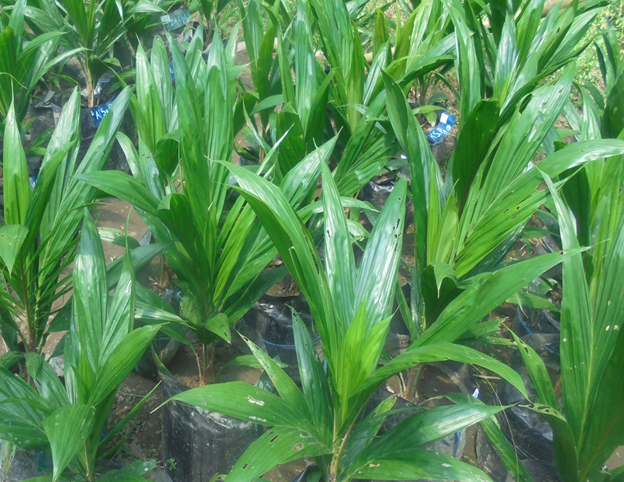
Root Morphology and Growth Response of Oil Palm (Elaeis guineensis Jacq) Hybrid to Al Toxicity at Nursery
Tri Utami(1*), Eka Tarwaca Susila Putra(2), Tohari Tohari(3)
(1) Faculty of Agriculture Universitas Gadjah Mada, Yogyakarta
(2) Faculty of Agriculture Universitas Gadjah Mada, Yogyakarta
(3) Faculty of Agriculture Universitas Gadjah Mada, Yogyakarta
(*) Corresponding Author
Abstract
The purpose of this study was to determine the response of eight oil palm hybrids through root morphological changes and growth to aluminum (Al) toxicity. The research was conducted in Sleman, Yogyakarta in June 2014 - June 2015. The study was prepared in a Factorial Randomized Block Design, with three replications as block. The first factor was was addition of aluminum in two rates (0 ppm and 300 ppm). The second factor eight oil palm hybrids (Yangambi, Avros, Langkat, PPKS 239, Simalungun, PPKS 718, PPKS 540 and Dumpy). The research was conducted at nursery stage. Observed variables include total root length, total root area, root volume, root diameter, aluminum uptake in root, fractal dimension, as well as fresh and dry root and shoot weight. The data obtained were analyzed by variant (ANOVA) at 5% level, followed by Duncan Multiple Range Test (DMRT) to find out if there was any real difference between the treatments. Aluminum at 300 ppm can change the morphological character of root, inhibiting root growth and biomass. All the hybrids give the same respon on root morphological and growth variables.
Keywords
Full Text:
PDFReferences
Astutiningsih, W. 2005. Kajian Fisiologis Cekaman Al dan Defisiensi P terhadap Pertumbuhan Bibit Padi Gogo dengan Tingkat Ketahanan yang Berbeda. Tesis : Universitas Gadjah Mada. Yogyakarta.
Eghball, B., J.R. Settimi, J.W. Maranville and A.M. Parkhurst. 1993. Fractal analysis for morphological description of corn roots under nitrogen stress. Agronomy Journal 85 : 287-289.
Fischer, R.A. and R. Maurer. 1978. Drought resistance in spring wheat cultivar: I. Grain yield response. Aust. J. Agric. Res. 29: 897-912.
Foy CD.1974. Effect of aluminum on plant growth. In Carson EW.(Ed). The Plant Root and Its Environment. p. 601-642. Charlottesville: University of Virginia.
Frageria, N.K., A.B. Santos, M.P.B. Filho, C.M. Guimaraes.2008. Iron toxicity in lowland rice. J. Plant Nutr. 31:1676-1697.
Indradewa D. 2002. Gatra agronomis dan fisiologis pengaruh genangan dalam parit pada tanaman kedelai, (Disertasi), Universitas Gadjah Mada Yogyakarta, Indonesia.
Kochian L.V. 1995. Celluler mechanism of aluminum toxicity and resistance in plant. Ann.Rev.Plant Physiol.Mol.Biol. 46 : 237-260.
Marschner, H. 1986. Mineral nutrition in higher plant. Academic Press Inc. London.
Marschner, H. 1995. Mineral nutrition of higher plant. 2nd . New York. Academic Press.
Muhammad, N. Gerald, and Z. Zhang. G. 2018. A review : the beneficial effect of aluminum on plant growth in acid soil and the possible mechanisms Journal of Integrative Agriculture 2018, 17: 60345-60347.
Polled EA and C.F. Konzak. 1990. Genetic and breeding of cereals for acid soil and nutrient efficiency, p. 81-131. In: Balligar V.C Duncan RR (eds). Crops as Enhancers of Nutrient Use.Academic Press. San Diego.
Proklamasiningsih, E., I.D. Prijambada, D. Rachmawati dan R.P. Sancayaningsih. 2012.
Pengaruh pemberian garam aluminium (Al) terhadap serapan Al dan pertumbuhan akar kedelai pada media tanam masam. J.Bionatura, 14: 107-114.
Pusat Penelitian dan Pengembangan tanah dan Agroklimat. 2000. Analisis potensi dan ketersediaan air berbasis daerah aliran sungai berdasarkan neraca air DAS.
Sanjay K. J, J. Naamala and F. D. Dakora. 2018. Nature and mechanisms of aluminium toxicity, tolerance and amelioration in symbiotic legumes and rhizobia. Biology and Fertility of Soils 54: 309-318
Shafaqat A., F. Z.B. Qiu, S. Cai, L. Qiu, F. Wu and G. Zhang. 2011. Interactive effects of aluminum and chrominum stresses on the uptake of nutrients and the metals in barley. Soil Science and Plant Nutrition, 57: 68-79.
Sopandie, D. 2013. Fisiologi adaptasi tanaman terhadap cekaman abiotik pada agroekosistem tropika. IPB Press. Bogor
Sutarta, E.S, dan Winarna. 2009. Pengaruh dosis logam berat terhadap pertumbuhan dan serapan hara bibit kelapa sawit. Jurnal Penelitian Kelapa Sawit. 17: 1-9.
Tatsumi, J., A. Yamauchi and Y. Kono.1989. Fractal analysis of plant root systems. Annal of Botany 64:499-503.
Taylor G.J. 1988. The physiology of aluminum phytotoxicity. In’Metal Ions in Biological Systems, p. 123-163. Sigel H and Sigel A (eds), Marcel Dekker Inc. New York.
Taylor G.J. 1991. Current views of the aluminum stress response; the physiological basis of tolerance. Curr Topics Plant Biochem Physiol, 10: 57-93.
Wilcove, D.S. and L.P. Koh. 2010. Addressing the threats to biodiversity from oil palm agriculture. Biodiver.Conserv 19 : 999-1000.
Yang, Y., M. Tang, R. Sulpice, H. Chen, S. Tian, dan Y. Ban. 2013. Arbuscular Mycorrhizal fungi alter fractal dimension characteristics of Robinia pseudoacacia L. seedlings trought regulating plant growth, leaf water status, photosynthesis, and nutrient concentration under drought stress. Jurnal Plant Growth Regul, 344 : 1-12.
Zioła-Frankowska A. And M. Frankowski.2018. Speciation analysis of aluminium in plant parts of Betula pendula and in soil. J Environ Sci, 65: 153-161.
Article Metrics
Refbacks
- There are currently no refbacks.
Ilmu Pertanian (Agricultural Science) ISSN 0126-4214 (print), ISSN 2527-7162 (online) is published by Faculty of Agriculture Universitas Gadjah Mada collaboration with Perhimpunan Sarjana Pertanian Indonesia (PISPI) and licensed under a Creative Commons Attribution-ShareAlike 4.0 International License.













